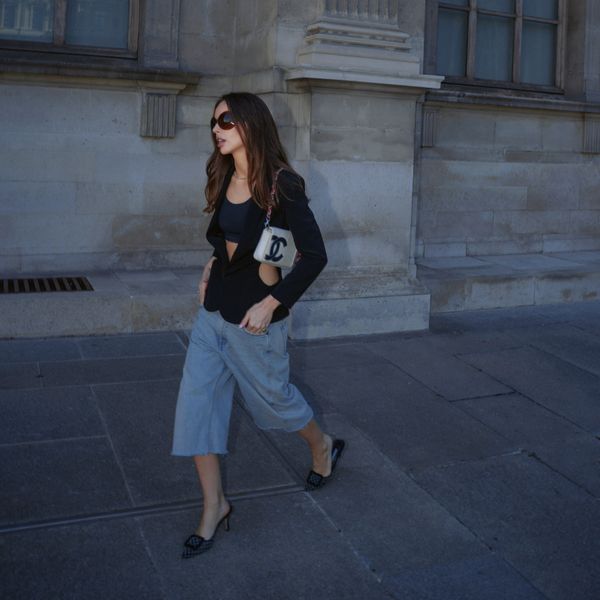Fitness
Restorative Yoga Poses and Stretches You Can Do at Home
Featuring constructive rest and six poses to open your hips, inner thighs, and more.
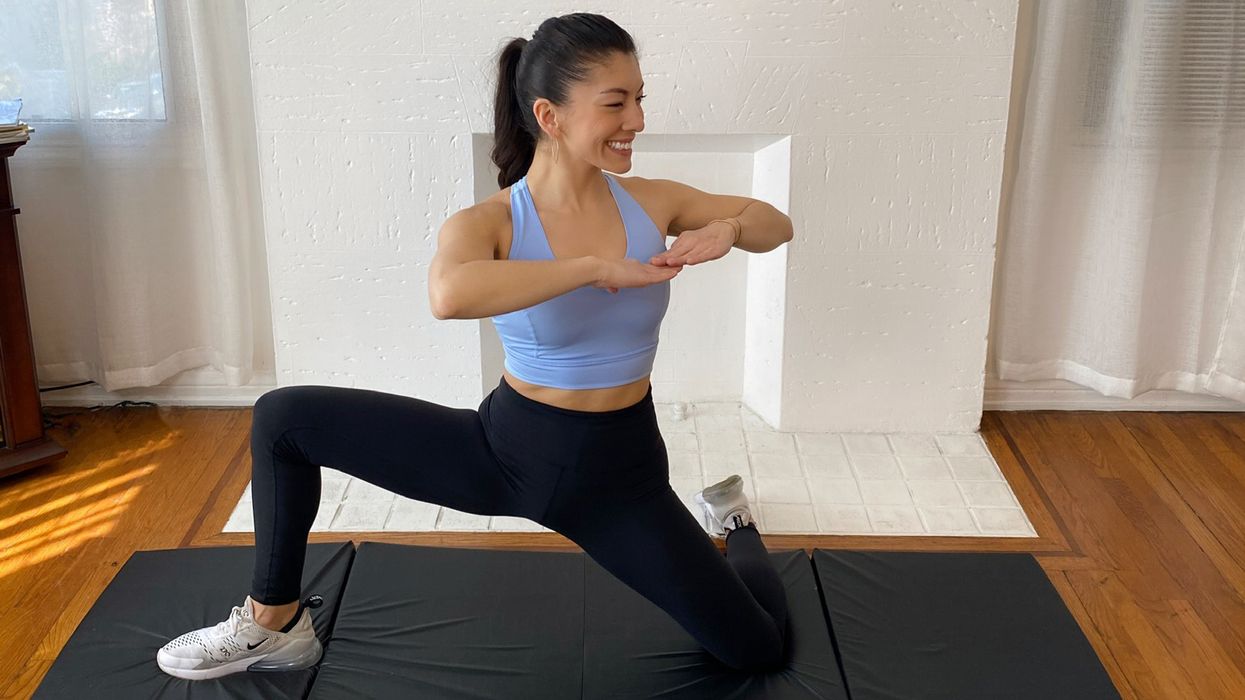
31 March, 2020
10 November, 2021
Now that lying on the floor has become something of a national pastime, it seemed like a good idea to find some actual activities to do while we’re down there. Rather than moaning, you might, for example, do some restorative yoga or some stretching. We chatted with yoga teacher Andrea Rice and P.volve LA lead trainer Dani Coleman about the best ways to relax and restore your body right now—because goodness knows we need it.
We’ll start with some simple constructive rest from Rice, and share a series of stretches from Coleman, so you can mix and match your relaxation routine. Or do both, if you’re really in need of some chill (or you’ve just completed another full day of working from home and you’re ready to scream into a pillow—either way).
We’ll start with some simple constructive rest from Rice, and share a series of stretches from Coleman, so you can mix and match your relaxation routine. Or do both, if you’re really in need of some chill (or you’ve just completed another full day of working from home and you’re ready to scream into a pillow—either way).
Constructive Rest for Chilling the F Out
“One of the best practices for stress and anxiety relief is constructive rest,” says Rice, whose new book, The Yoga Almanac, offers 52 practices to help keep you grounded all year long. “Sometimes called ‘active rest,’ constructive rest is just that—a grounding, stabilizing position that is less passive than a traditional savasana.” Rather than just lying in “corpse pose,” or savasana—that groovy part of every yoga class that just lets you lie on the floor and do nothing—there’s a little more to constructive rest (though just a little). And it feels fantastic on your poor, aching muscles.
“The shape releases tension in the hip flexors, particularly the psoas muscles, and allows the spine to rest in its natural curves at the lumbar and cervical regions,” Rice says. Are you ready to throw yourself on the floor yet? We are. “The psoas are the only muscles that attach your legs to your spine, which is why you experience lower back discomfort and tightness whenever your hips are tight,” she explains. “The psoas muscles also connect to the T12 vertebrae at the thoracic spine, the same place where the diaphragm connects. These ‘muscles of the soul’ can also cause shortness of breath and even trigger symptoms of anxiety.”
We’re all feeling a little—or a lot—more anxious than usual, so Rice suggests that you try constructive rest, which “relaxes the psoas to regulate the diaphragm and invite ease into body and mind.” It taps into the parasympathetic nervous system, which is the part of the central nervous system “that helps you be more responsive versus reactive,” Rice says. “If you only do one yoga pose a day, this may very well be your new go-to, especially during unsteady times.”
“To begin, lay on your back with your knees bent and feet on the floor,” she instructs. “Adjust the placement of your feet—whether that’s outer or inner hips-width distance apart—until the shape feels well supported and natural.”
Next, find your neutral spine. “Sway your knees from side to side, pause, and then rock your pelvis forward and back a few times to establish your neutral spine: a C-shape curve in your lower back and S-shape curve at the back of your neck,” Rice says. For those of us who do yoga or Pilates, this neutral spine is second nature, but if you aren’t used to finding this at home, try arching your back and then tilting your pubic bone toward your face; your neutral spine is just in between the two extremes.
“Make sure there’s a little space between your chin and chest,” Rice says. “You might rock your head gently from side to side a few times before settling in. Place your arms out wide beside you, and feel your thoracic spine anchoring to the ground as you invite more spaciousness to the area between your shoulder blades.”
Next, it’s time to focus on your breath. “Close your eyes and bring your attention to your breathing, steadying your mind by following the rise of each inhale and the fall of each exhale for several rounds of breath,” Rice says. “Then bring your attention to sensation by conducting a brief body scan, feeling the weight and rootedness of the various anchor points where your body is making contact with the floor, starting with the feet, then the back of your pelvis, the back-body, the backs of the arms, and the back of your skull.” Also, try not to fall asleep.
Constructive rest also puts emphasis on listening to the sounds around you, much like some meditation practices. “Bring your attention to sound,” Rice says. “Perhaps beginning with the sound of your breathing, and then allowing your attention to drift outward to the sounds all around you, even the faint sounds coming in from the outside. Notice which of the three anchors keeps you the most present and engaged: Is it breath, sensation, or sound?” Regardless of what you hear, keep your mind on your breath. “Each time your mind starts to wander away, use that anchor to bring you back,” Rice says. “Continue breathing slowly, cyclically, rhythmically, until the breath can simply ebb and flow on its own with little to no effort.”
From here, you don’t have to stay in formal meditation. “Stay here as long as you like—maybe with a good book,” Rice says.
Active Stretching to Open Your Body
For all these, P.volve LA trainer Dani Coleman suggests you do six to eight reps of each on both sides. But if that feels overwhelming, don’t worry about it. Stretch to your heart’s content—whatever level of content that may be.
Internal 45 with Overhead Stretch
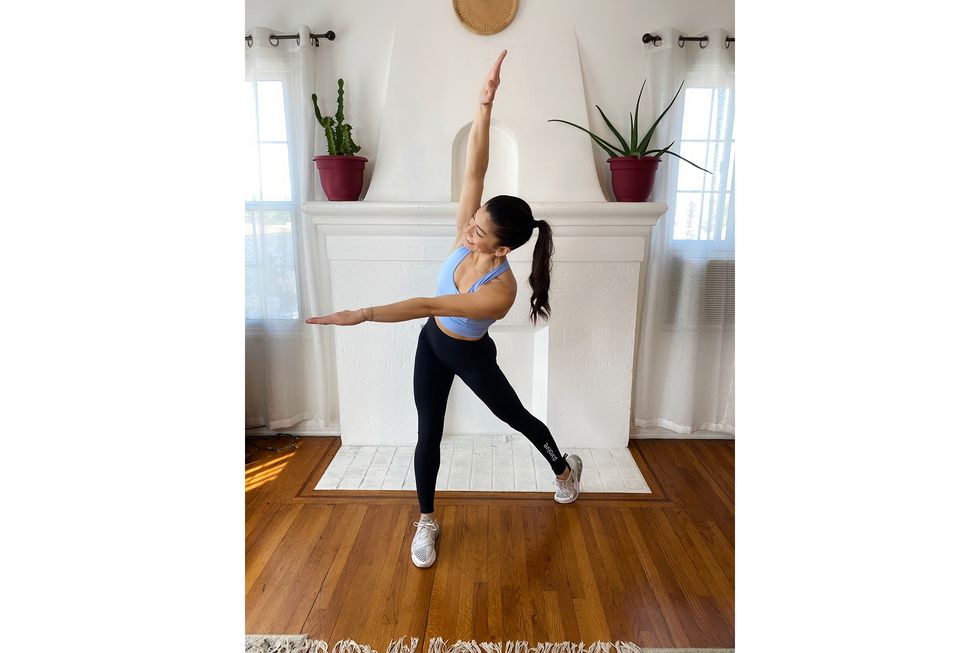 Photo: Courtesy of Dani Coleman
Photo: Courtesy of Dani Coleman
Start with your “front foot parallel, foot facing forward, as the back leg is rotated internally at 45 degrees with the heel raised—think that you’re wearing a high heel,” Coleman tells us. “Reach the front arm towards the standing leg as you rotate into the core.” We tried this at home, and let us be the first to say: This alone feels damn good.
Next, reach your back arm “up and over as you lengthen out of the midline and press into the standing glute for a deep stretch,” Coleman says. When you’re done with all that, return back to a neutral position, or what Coleman calls a “p.sit,” which seems to be a fitness-y version of yoga’s mountain pose.
Coleman’s instructions for a p.sit: “Lift arms to shoulder height; squeeze your glutes; reach your tailbone back; incline chest slightly; pull abs in; low back long; knees directly over ankles; soft bend in knees.”
Next, reach your back arm “up and over as you lengthen out of the midline and press into the standing glute for a deep stretch,” Coleman says. When you’re done with all that, return back to a neutral position, or what Coleman calls a “p.sit,” which seems to be a fitness-y version of yoga’s mountain pose.
Coleman’s instructions for a p.sit: “Lift arms to shoulder height; squeeze your glutes; reach your tailbone back; incline chest slightly; pull abs in; low back long; knees directly over ankles; soft bend in knees.”
Side Lunge with Rotation
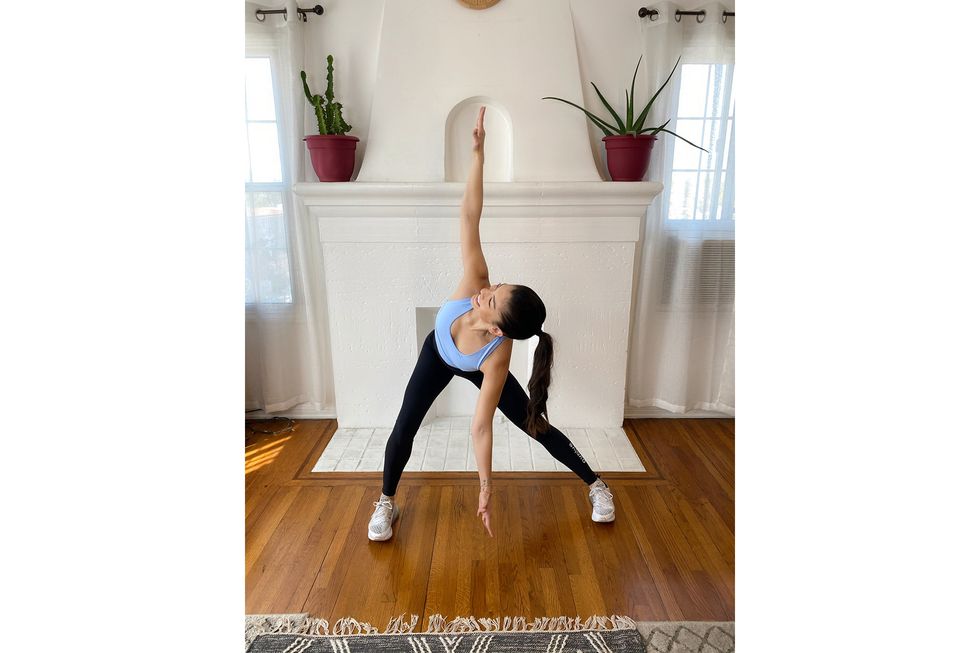 Photo: Courtesy of Dani Coleman
Photo: Courtesy of Dani Coleman
The fitness world’s answer to triangle pose! For this one, “step laterally out, keeping the leg stacked knee-over-ankle with a soft bend in the knee,” Coleman says. “Other leg is lengthened out, feeling the inner thigh stretch.” She had us at inner thigh stretch.
“Rotate into the core as you reach up to the ceiling and follow your focus with your gaze,” Coleman continues. “Then, close the arm pressing through your muscle tension, feeling a deep stretch in the back glute, inner thigh, core, and upper body.”
“Rotate into the core as you reach up to the ceiling and follow your focus with your gaze,” Coleman continues. “Then, close the arm pressing through your muscle tension, feeling a deep stretch in the back glute, inner thigh, core, and upper body.”
Step Back with Forward Hinge
 Photo: Courtesy of Dani Coleman
Photo: Courtesy of Dani Coleman
This one starts with—you guessed it—a step back. “Take a step back with a high heel,” Coleman says. “Make sure your abs are engaged and you maintain a low back long as you press the arms down and hinge over the standing leg.”
Next, “drive through the front heel to activate the hamstring to return the arms and body back upright, feeling the stretch in the hips, hamstrings, core, and glutes,” she says. Any of these could be done piecemeal, between tasks throughout the day, to help feel more like a human and less like a robot.
Next, “drive through the front heel to activate the hamstring to return the arms and body back upright, feeling the stretch in the hips, hamstrings, core, and glutes,” she says. Any of these could be done piecemeal, between tasks throughout the day, to help feel more like a human and less like a robot.
Kneeling Sit with Rotation
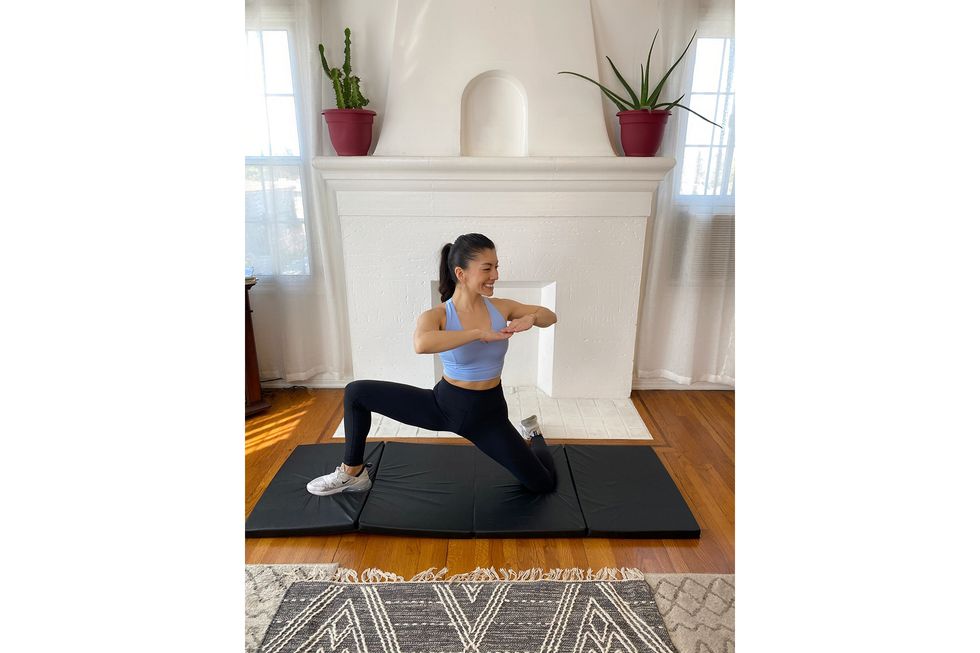 Photo: Courtesy of Dani Coleman
Photo: Courtesy of Dani Coleman
This one will open up your hips. (Insert high-five emoji here.) “Step the leg out wide laterally, feeling the extension of the hip and stretch of the inner thigh,” Coleman says. “With your arms in a T position as you rotate the core away from the leg, drive into the heel, activating the inner thigh, and press into the outer leg as you deepen the stretch in the inner thigh.” In particular, she says, this one is great after sitting all day.
Kneeling Hip Stretch with Overhead Reach
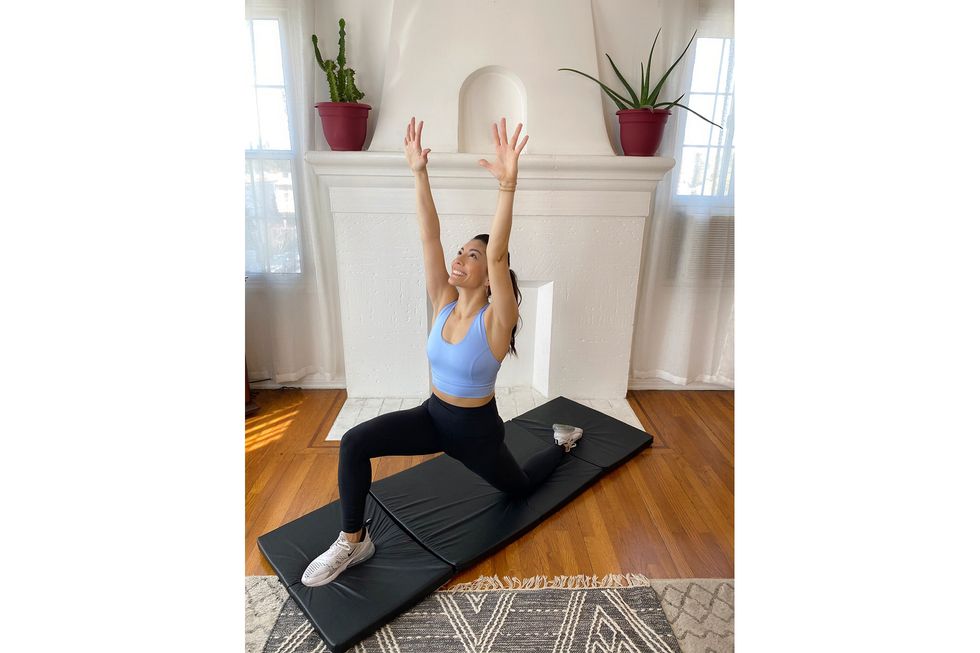 Photo: Courtesy of Dani Coleman
Photo: Courtesy of Dani Coleman
“Step the leg out in front of the body, keeping the knee over the ankle and not in front of the ankle,” Coleman says. “Reach the arms up as you squeeze the back glute and slightly press the pelvis forward, deepening the stretch in the hips and lengthening the midline out and up.” Et voilà: You instantly feel taller.
Side Lunge Kneeling
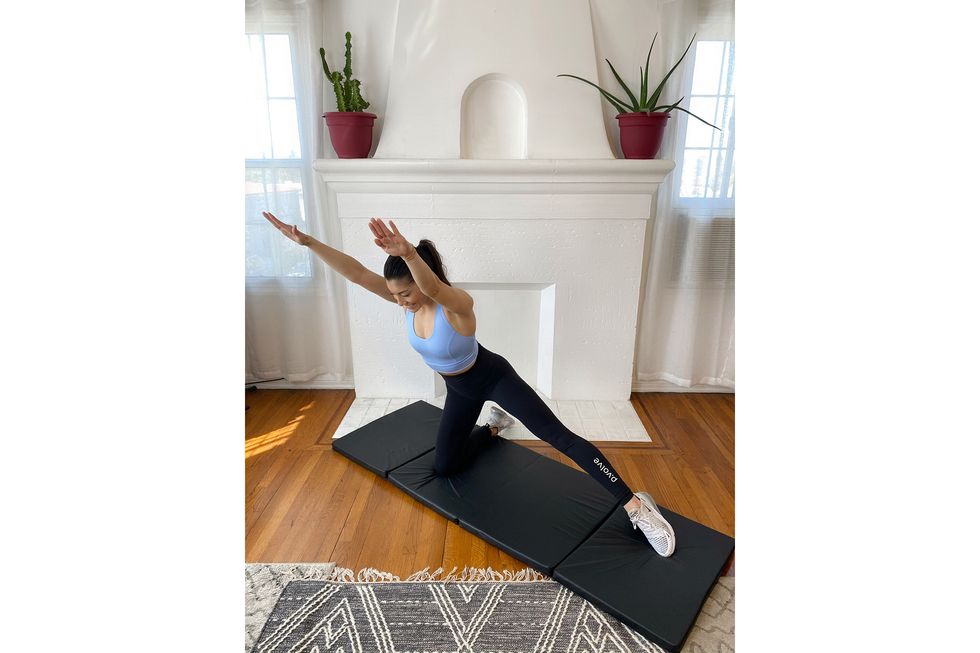 Photo: Courtesy of Dani Coleman
Photo: Courtesy of Dani Coleman
“Outstretch the arms above the heart as your leg lengthens to the side, pointing your shoelaces forward and lifting the heel so the ankle is supported,” Coleman says. “Squeeze the glutes, and try to reach the tailbone back further to deepen the kneeling glute stretch and inner thigh.” The length you feel just might make you forget you haven’t hung out with your friends in weeks. At least for a few minutes.
Photos: Courtesy of Dani Coleman
Want more stories like this?
21 Funny Shows and Movies to Stream Right Now
You Can Actually Pronounce This Wellness Trend
Feeling Anxious? Try One of These Products for Some Quick Relief
Photos: Courtesy of Dani Coleman
Want more stories like this?
21 Funny Shows and Movies to Stream Right Now
You Can Actually Pronounce This Wellness Trend
Feeling Anxious? Try One of These Products for Some Quick Relief



